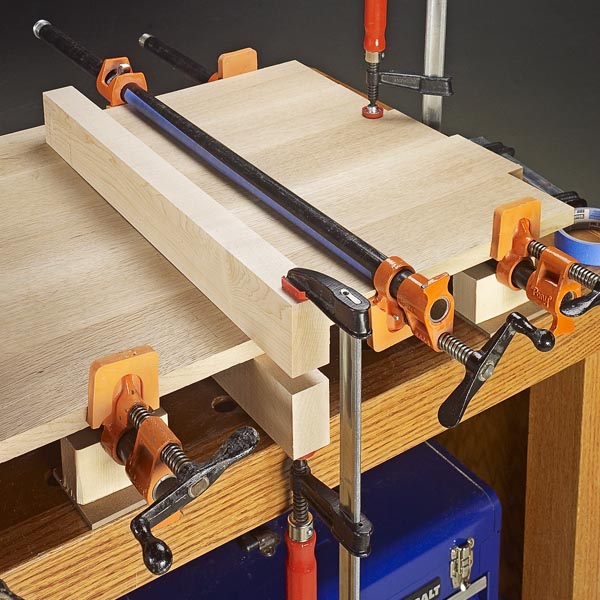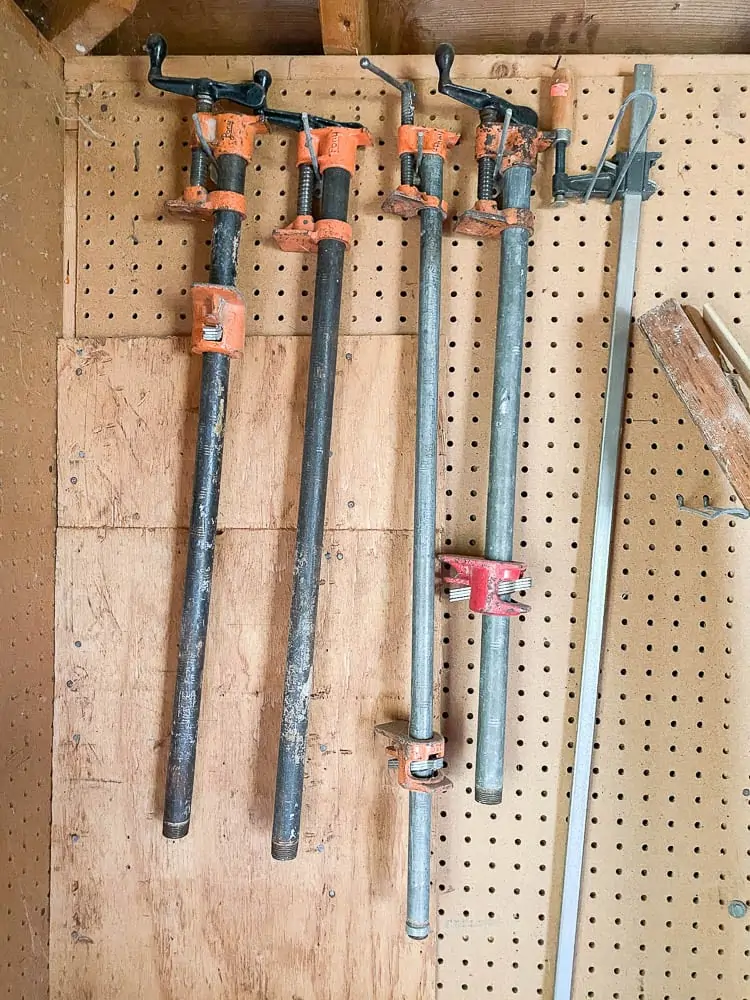When it comes to woodworking, every aspiring craftsman knows the importance of having the right tools. And if you’re wondering, “Are pipe clamps good for woodworking?”, you’ve come to the right place!
Pipe clamps are like the superheroes of the woodworking world, offering strength, versatility, and precision. They are a must-have for any woodworking project, whether you’re building furniture, assembling cabinets, or working on smaller pieces.
In this article, we’ll explore the benefits of using pipe clamps in woodworking and how they can take your craftsmanship to the next level. So, grab your tool belt and let’s dive into the world of pipe clamps!

Are Pipe Clamps Good for Woodworking?: A Comprehensive Guide
Woodworking is a craft that requires precision and stability. One essential tool that every woodworker should have in their arsenal is a pipe clamp. Pipe clamps are versatile and reliable tools that can be used for various woodworking tasks. But are pipe clamps really good for woodworking? In this article, we will explore the benefits, uses, and tips for using pipe clamps in woodworking.
The Benefits of Pipe Clamps in Woodworking
When it comes to woodworking, having a tool that provides strength and stability is crucial. Here are some key benefits of using pipe clamps:
1. Versatility and Adjustability
Pipe clamps are highly versatile and can be adjusted to accommodate different project sizes. The threaded pipes can be extended or retracted to fit the length needed, making them suitable for both small and large woodworking projects. This adaptability allows woodworkers to have a single tool that can be used for various applications.
Additionally, pipe clamps can be combined with other clamps or accessories to create a custom setup tailored to specific woodworking tasks. This flexibility makes pipe clamps a favorite among woodworkers with different project needs.
2. Strong and Even Pressure
One of the most important factors in woodworking is maintaining even pressure during glue-ups or when clamping pieces together. Pipe clamps excel in providing strong and consistent pressure across the entire length of the workpiece, ensuring a tight and secure bond. The long jaws of the clamp distribute pressure evenly, minimizing the risk of uneven clamping that could lead to misaligned joints.
Furthermore, the mechanical advantage of pipe clamps allows woodworkers to apply significant pressure with minimal effort. This is especially beneficial when working with hardwoods or when gluing multiple boards together.
3. Cost-Effective
Compared to other types of clamps, pipe clamps are relatively affordable and offer excellent value for money. They are sturdy, durable, and can withstand the demanding pressures of woodworking tasks. Pipe clamps are readily available at hardware stores and online, making them accessible to woodworkers of all skill levels and budgets.
Additionally, pipe clamps are a long-term investment. With proper care and maintenance, they can last for years, making them a cost-effective solution for woodworking projects.
Tips for Using Pipe Clamps in Woodworking
Now that we’ve discussed the benefits of pipe clamps, here are some tips for utilizing them effectively in your woodworking projects:
1. Choose the Right Pipe Diameter
When selecting pipe clamps, consider the diameter of the pipes. Thicker pipes offer more rigidity and are recommended for larger projects, while thinner pipes are suitable for smaller projects that require less clamping force. Make sure to select the appropriate diameter based on the size and scope of your woodworking project.
2. Use Protective Pads
To prevent the clamp jaws from marring the surface of your workpiece, it is advisable to use protective pads. These can be as simple as pieces of scrap wood or soft materials like leather or rubber. By placing them between the clamp jaws and the wood, you can protect the surface while still applying even pressure.
3. Check Alignment and Squareness
Prior to clamping, double-check the alignment and squareness of your workpieces. This will help you achieve accurate results and eliminate the need for corrective measures after the glue-up. Use measuring tools like a combination square or a level to ensure your pieces are properly aligned before tightening the pipe clamps.
4. Distribute Clamping Pressure Evenly
When clamping, start by applying light pressure across the entire length of the workpiece. Gradually increase the pressure, ensuring that it is distributed evenly. This technique helps prevent any shifting or misalignment during the clamping process.
5. Allow Sufficient Drying Time
After clamping, it is important to give the glue sufficient drying time before removing the pipe clamps. Follow the manufacturer’s instructions for the specific glue you are using, as drying times can vary. Rushing the process and removing the clamps too soon can compromise the integrity of the joint and lead to weak or failed bonds.
Common Myths About Pipe Clamps
Despite their many benefits, there are a few misconceptions about pipe clamps in woodworking. Let’s debunk some common myths:
1. Pipe Clamps Can Only Be Used for Large Projects
While pipe clamps are indeed suitable for larger projects, they can also be adjusted to accommodate smaller pieces. The extendable nature of the threaded pipes allows for versatility, making them a versatile tool for projects of all sizes.
2. Pipe Clamps Don’t Provide Enough Pressure
This is a common misconception. Pipe clamps are capable of providing substantial pressure, thanks to their mechanical advantage and long jaws that distribute force evenly. With proper technique and adjustment, pipe clamps can generate significant pressure for secure and tight clamping.
3. Pipe Clamps Are Complicated to Use
While pipe clamps may initially seem intimidating, they are actually simple to use. With a bit of practice and familiarity, woodworkers of all skill levels can quickly become comfortable using pipe clamps. It’s all about understanding how to adjust and position them for optimum pressure and stability.
In conclusion, pipe clamps are indeed good for woodworking. They provide versatility, strong and even pressure, and are cost-effective. By following the tips provided and debunking common myths, you can confidently incorporate pipe clamps into your woodworking projects and enhance your craft.
Key Takeaways: Are Pipe Clamps Good for Woodworking?
- Pipe clamps are versatile and useful tools for woodworking projects.
- They provide strong and secure clamping pressure, making them ideal for holding wood pieces together during glue-ups.
- Pipe clamps come in various sizes, allowing for flexibility in woodworking projects.
- They are affordable and a great addition to any woodworker’s toolkit.
- Proper setup and adjustment of pipe clamps is essential for ensuring accurate and successful woodworking.
Frequently Asked Questions
As you embark on your woodworking journey, choosing the right tools and equipment is crucial. Pipe clamps are a versatile option for woodworkers, offering various benefits. Here are some common questions people have about using pipe clamps for woodworking.
Q: How do pipe clamps compare to other types of clamps for woodworking?
Pipe clamps are an excellent choice for woodworking due to their versatility and affordability. Unlike other clamps, pipe clamps allow you to customize the length according to your project needs. Additionally, pipe clamps have a high clamping force, ensuring a secure grip on your workpiece. This makes them suitable for various woodworking applications.
When compared to other types of clamps like bar clamps or C-clamps, pipe clamps are often more cost-effective and easily adjustable. They provide great value for money without compromising on performance, making them a popular choice among woodworkers of all skill levels.
Q: Can pipe clamps exert enough pressure for woodworking projects?
Absolutely! Pipe clamps are designed to exert significant pressure on your workpiece. With their sturdy construction, these clamps can apply high clamping force, ensuring a secure and tight grip. The amount of pressure a pipe clamp can exert depends on the diameter and length of the pipe used.
One advantage of pipe clamps is that you can easily increase the clamping pressure by adding more pipes or using longer pipes. This allows you to adapt to the needs of your woodworking project and ensure the stability of your workpiece.
Q: Are pipe clamps suitable for large woodworking projects?
Yes, pipe clamps are a great choice for large woodworking projects. Their adjustable length feature allows you to accommodate different sizes of workpieces. By using longer pipes, you can extend the clamping capacity to tackle larger projects.
When working on larger projects, it’s important to ensure that you have sufficient support throughout the entire length of the workpiece. By strategically placing pipe clamps at regular intervals, you can distribute the pressure evenly, providing stability and preventing any potential warping or bending.
Q: Can pipe clamps leave marks or damage the wood?
When used correctly, pipe clamps should not leave any marks or damage the wood. To protect the surface of your workpiece, it is advisable to place wood pads or cauls between the clamp jaws and the wood. This helps distribute the pressure evenly and prevents any indentation or marks.
Additionally, it’s important to check that the pipe clamp jaws are free from any debris or irregularities that could potentially scratch the wood. Regularly inspecting and maintaining your clamps will ensure they are in optimal condition and won’t cause any damage to your woodworking projects.
Q: Are pipe clamps a versatile option for woodworking?
Definitely! Pipe clamps are incredibly versatile and can be used for various woodworking applications. Whether you’re building furniture, cabinets, or even working on smaller projects, pipe clamps provide the flexibility and adaptability needed.
The adjustable feature of pipe clamps allows you to customize the length according to your project requirements. They can be used to join pieces of wood, apply pressure during glue-ups, or secure workpieces for sanding or routing. With their wide range of uses, pipe clamps are a must-have tool in any woodworker’s arsenal.

Which woodworking clamps should you buy?
Summary
Pipe clamps are a versatile tool for woodworking with many benefits. They provide a strong grip on materials, making them perfect for holding pieces together during glue-ups or clamping projects. They are adjustable and can accommodate different sizes of materials, allowing for flexibility in woodworking projects. Pipe clamps are also durable and affordable, making them a great option for beginners or those on a budget.
However, pipe clamps also have some limitations. They require additional accessories, like pipe lengths, to function properly, which can add to the cost. They can also be heavier and bulkier compared to other clamps, which may make them less convenient to transport. Despite these limitations, pipe clamps remain a popular choice for many woodworkers due to their strength, versatility, and cost-effectiveness. So, if you’re starting out in woodworking or need a reliable and affordable clamp, pipe clamps are definitely worth considering.
